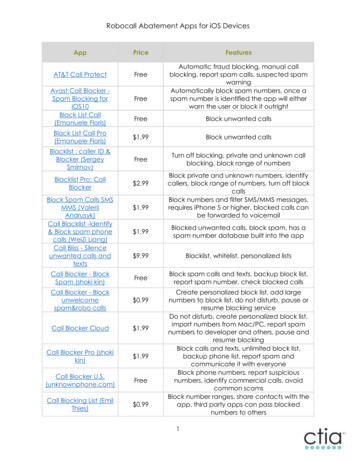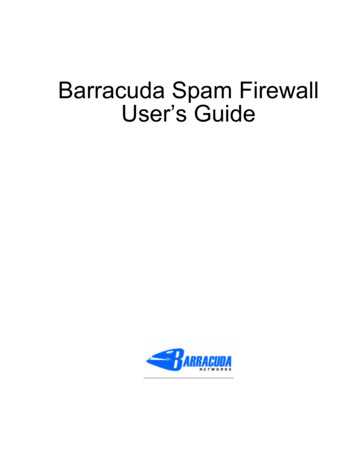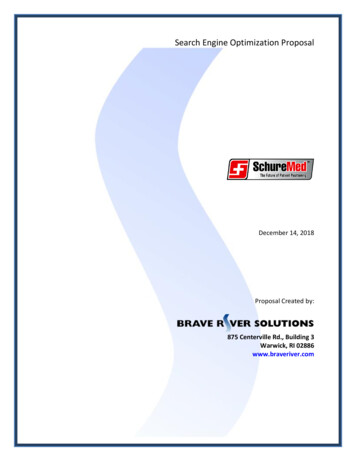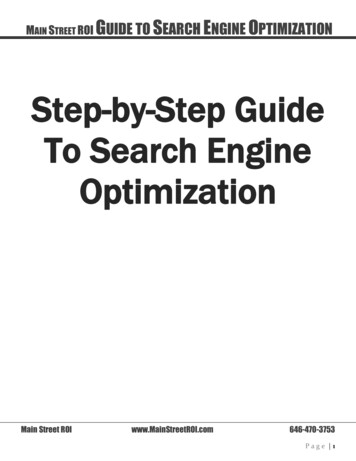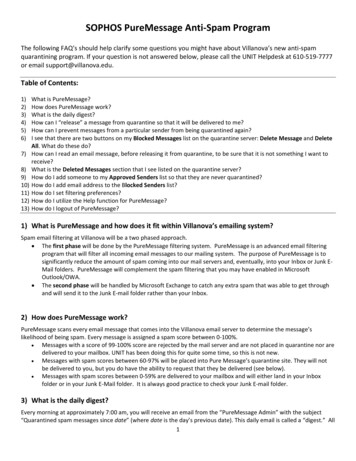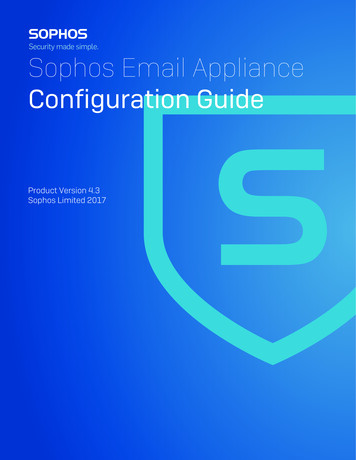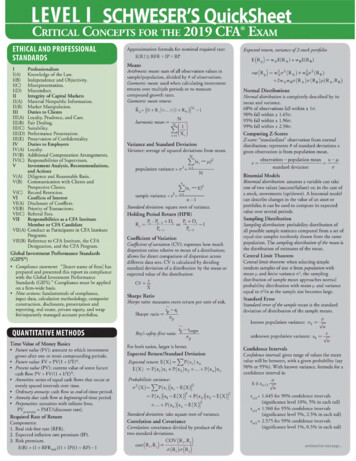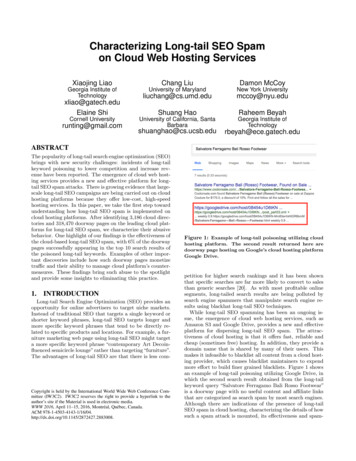
Transcription
Characterizing Long-tail SEO Spamon Cloud Web Hosting ServicesXiaojing LiaoChang LiuDamon McCoyGeorgia Institute ofTechnologyUniversity of MarylandNew York tech.eduElaine ShiCornell Universityrunting@gmail.comShuang HaoRaheem BeyahUniversity of California, SantaBarbaraGeorgia Institute .eduABSTRACTThe popularity of long-tail search engine optimization (SEO)brings with new security challenges: incidents of long-tailkeyword poisoning to lower competition and increase revenue have been reported. The emergence of cloud web hosting services provides a new and effective platform for longtail SEO spam attacks. There is growing evidence that largescale long-tail SEO campaigns are being carried out on cloudhosting platforms because they offer low-cost, high-speedhosting services. In this paper, we take the first step towardunderstanding how long-tail SEO spam is implemented oncloud hosting platforms. After identifying 3,186 cloud directories and 318,470 doorway pages on the leading cloud platforms for long-tail SEO spam, we characterize their abusivebehavior. One highlight of our findings is the effectiveness ofthe cloud-based long-tail SEO spam, with 6% of the doorwaypages successfully appearing in the top 10 search results ofthe poisoned long-tail keywords. Examples of other important discoveries include how such doorway pages monetizetraffic and their ability to manage cloud platform’s countermeasures. These findings bring such abuse to the spotlightand provide some insights to eliminating this practice.1.INTRODUCTIONLong-tail Search Engine Optimization (SEO) provides anopportunity for online advertisers to target niche markets.Instead of traditional SEO that targets a single keyword orshorter keyword phrases, long-tail SEO targets longer andmore specific keyword phrases that tend to be directly related to specific products and locations. For example, a furniture marketing web page using long-tail SEO might targeta more specific keyword phrase “contemporary Art Decoinfluenced semicircle lounge” rather than targeting “furniture”.The advantages of long-tail SEO are that there is less com-Copyright is held by the International World Wide Web Conference Committee (IW3C2). IW3C2 reserves the right to provide a hyperlink to theauthor’s site if the Material is used in electronic media.WWW 2016, April 11–15, 2016, Montréal, Québec, Canada.ACM 2872427.2883008.Figure 1: Example of long-tail poisoning utilizing cloudhosting platform. The second result returned here aredoorway page hosting on Google’s cloud hosting platformGoogle Drive.petition for higher search rankings and it has been shownthat specific searches are far more likely to convert to salesthan generic searches [20]. As with most profitable onlinesegments, long-tailed search results are being polluted bysearch engine spammers that manipulate search engine results using blackhat long-tail SEO techniques.While long-tail SEO spamming has been an ongoing issue, the emergence of cloud web hosting services, such asAmazon S3 and Google Drive, provides a new and effectiveplatform for dispersing long-tail SEO spam. The attractiveness of cloud hosting is that it offers fast, reliable andcheap (sometimes free) hosting. In addition, they provide adomain name that is shared by many of their users. Thismakes it infeasible to blacklist all content from a cloud hosting provider, which causes blacklist maintainers to expendmore effort to build finer grained blacklists. Figure 1 showsan example of long-tail poisoning utilizing Google Drive, inwhich the second search result obtained from the long-tailkeyword query “Salvatore Ferragamo Bali Rosso Footwear”is a doorway page with no useful content and affiliate linksthat are categorized as search spam by most search engines.Although there are indications of the presence of long-tailSEO spam in cloud hosting, characterizing the details of howsuch a spam attack is mounted, its effectiveness and spam-
mers’ ability to evade cloud platform’s countermeasures havenot been documented.In this paper, we conduct the first measurement study oflong-tail SEO spam hosted on cloud platforms. We bootstrapped our study by identifying spam cloud directorieson cloud hosting platforms, in which doorway pages havelargely homogeneous content in terms of their keywords andDOM structures. This enabled us to locate 930 spam clouddirectories on Amazon S3 and 672 spam cloud directories onGoogle Drive, as well as other cloud platforms. Our analysisof the doorway pages’ content revealed that they were utilizing relatively unsophisticated blackhat SEO techniques,such as keyword stuffing (which is the repetition of keywordphrases multiple times) and keyword spam (which includesunrelated keywords). Also, we found that the SEO spammers made use of evasion techniques, such as link shortenersand obfuscated client-side JavaScript to hide affiliate linkswhen cloud platforms do not support server-side scripting.In order to understand the effectiveness of these longtail SEO spam campaigns, we monitored 236,368 long-tailedkeyword searches over the course of one year. Based on ouranalysis, we observed that 6% of the cloud-hosted doorwaypages polluted the top 10 search results of long-tail keywords, and 32% of the top 100 search results. These doorway pages indicate the high-level of effectiveness of pollutinglong-tailed search results. We also found that almost all ofthe doorway pages were monetized by including links to reputable affiliate programs such as Prosperent, ClickBank andVigLink.To understand the profitability of long-tail SEO spam oncloud hosting platforms, we analyzed the estimated revenueand click-through rate for a single campaign, which showedspammers were earning a modest sum of approximately 400USD each per month. In addition, we noted that their clickthrough rates were increasing by 20% over time. Finally,we monitored ongoing interventions by the cloud serviceproviders. We found that service providers’ efforts to detect and remove doorway pages had limited effectiveness, aslong-tail SEO campaigns remained active. Doorway pageson cloud hosting platforms have an average lifetime of 7weeks, which is much longer than those hosted on traditional platforms (i.e., 1 week [10]).To the best of our knowledge, our study is the first topresent a comprehensive understanding of long-tail SEO spamon cloud web hosting platforms and its effects. We summarize our main contributions as follows:Doorway pagebuy-cheap-nike.htmlCloud directoryreviewbuyCloud hosting platforms3.amazonaws.comCloud busive userVisitorLanding siteFigure 2: An example of long-tail SEO on a cloud hosting platform.long-tail SEO effectiveness on the cloud platforms, followedby an analysis of traffic monetization in Section 5. Section 6reports the effectiveness of interventions conducted by cloudservice providers, while Section 7 discusses the limitationsof our technique and potential future work. The paper concludes with a look at related works and a brief summary ofthe paper’s findings in Section 8 and Section 9.2.BACKGROUNDIn this section, we present some background informationon three areas of importance to this paper. First, we explainthe basics of cloud hosting, followed by why long-tail SEO isbeneficial to both web page hosts and potential audiences.Lastly, we present the adversarial model used in planningour study.Cloud hosting. Cloud hosting is a type of “infrastructureas a service (IaaS)”, which is rented by a cloud user to hosther web page. These web pages are organized into clouddirectories identified by unique, user-assigned keys that aremapped as unique sub-domains. The web page stored inthe cloud directories can be served directly to users via filenames in a relative path (i.e., cloud URL). This processis known as built-in site publishing [9]. For instance, anHTML file hosted in a cloud directory can be directly runin a browser and visited by the public as a web page via thecloud URL.In recent years we have seen an increase in popularity ofcloud hosting services. Pay-as-you-go cloud hosting is wellreceived as an economic and flexible computing solution.As an example, Google Drive today offers a free web hosting service with 15GB of storage, and an additional 100GB1. We propose a methodology to identify cloud directofor 1.99/month, and GoDaddy’s web hosting starts fromries containing long-tail SEO spam, which discoveredmerely 1/month for 100GB. The pay-as-you-go feature on3,186 abusive cloud directories on 10 mainstream cloudcloud web hosting enables multiple low-cost permanent orplatforms.temporary websites such as start-up websites (e.g., yelp),2. We conduct a measurement study of long-tail SEOresearch project websites (e.g., NASA/JPL’s Mars Curiosspam on the cloud, which provides insights into itsity Mission) and political campaign websites (e.g., Obamaeffectiveness, its use of cloud resources, network charfor America Campaign 2012). Additionally, spam campaignsacteristics and revenue models.3. Our empirical study shows that the cloud service provider’s also utilize cloud web hosting for marketing promotion.Long-tail SEO. Long-tail SEO optimizes doorway pages forefforts to prevent these abusive usages are yet to be eflonger and more specific keyword phrases (i.e., long-tail keyfective.word). With long-tail keywords, a doorway page can attractThe rest of the paper is organized as follows: Section 2exactly the audience looking for that specific product, and aspresents the background information and adversary modela result, that audience will be far closer to point-of-purchasefor our research, while the method by which we collected[20]. Also, compared with shorter keywords, competition fordata and identified spam cloud directories is discussed inrankings can be less fierce, and the doorway page can moreSection 3. Section 4 reports the details of our analysis abouteasily achieve a high search ranking.
For example, a doorway page to promote classic furnitureis highly unlikely to appear near the top of an organic searchfor “furniture” because there is too much competition. Butif the doorway page specializes in, say, contemporary artdeco furniture, then long-tail keywords like “contemporaryArt Deco-influenced semi-circle lounge” are going to reliablyfind those consumers looking for that exact product.Adversary model. In our research, we consider the abusive users who try to use cloud web hosting service for longtail SEO spam. For this purpose, an abusive user could buildher own cloud directories to store a large amount of doorwaypages, which are optimized for long-tail keywords.Figure 2 illustrates an example of long-tail SEO spamon cloud hosting service. An abusive user creates a clouddirectory on the cloud hosting platform and uploads largeamount of doorway pages for long-tail SEO spam (Ê). Toattract clicks, an abusive user would utilize blackhat SEOtechniques to pollute the search engine’s long-tail keywords(Ë) and manipulate the search ranking (Ì). When visitingthe doorway page from the poisoned search engine results(Í), a visitor will be redirected to a landing site (Î) fromwhich the abusive user will obtain a marketing commission(Ï).3.ABUSIVE CLOUD DIRECTORY IDENTIFICATIONIn this section, we explain the methodology used in ourstudy for abusive cloud directory identification. In the datacollection stage, we first selected SEO targeted keywords tofeed the search engine to identify the doorway pages on thecloud hosting service. Then, we utilized the directory structure of cloud hosting service to find other doorway pages.In the abusive cloud directory identification stage, since thelong-tail SEO campaigns show high similarity in page contents in the same directories, we trained a classifier to identify the cloud directories hosting long-tail SEO spam.3.1Data CollectionIn the data collection stage, we first collected the ‘seed’web pages on the cloud hosting service. Specifically, wefed the SEO targeted keywords to the search engine, andused the Google Web Search API to pull the links that appeared in the search results. Second, since the web pages onthe cloud platforms are organized into directories, we alsocrawled additional web pages in the same directories. Then,a web crawler followed the links in the page, collected theirredirection chains, and stored the intermediate URL information in our local database.Seed Data Collection. Selecting appropriate keywordphrases to feed the search engine is critical for obtainingrepresentative results. To analyze the long-tail SEO spam incloud hosting services, we first choose ‘hot’ keyword phrasesand spammy keywords phrases. These keywords reflect whatpeople are searching for and what SEOs are targeting. Further, we use the Google Web Search API to pull the top100 search results for each term from the Google search engine. In this paper, we analyze the long-tail SEO spam on10 leading cloud hosting services as listed in Table 1. Thisset of crawled pages is defined as a seed dataset Ds , whichcontains 32,177 cloud URLs and 20,328 cloud directories.For the first set of search terms, we employ popular trending keywords from Google Trend hot keywords [6]. We col-Table 1: List of cloud hosting platforms.Cloud PlatformHerokuAmazon et.orgsinaapp.comduapp.comolympe.inTable 2: Summary results of the datasets.Name# of URLsDsDd32,1771,073,642# ofcloud directories20,32815,774# ofkeywords1,500NaNlect the top 20 popular search terms in 64 categories acrossvarious search interests including entertainment, educationand technology. For the second set of search terms, we target some specific keywords which spammers also target. Weutilized a spam trigger word list [4], which includes 200spammy words such as “payday loan” and “casino no deposit”. In addition, we gathered 20 pharmaceutical keywords, including a number of the most-prescribed and bestselling product terms from IMS Health [14]. Note that torestrict the search results to each cloud platform, we included the query “site:cloud service’s domain name” (e.g.,site:s3.amazonaws.com) before the aforementioned keywordphrases.Directory Dataset Collection. On the cloud hosting service, the web pages are organized as directories. For example, a typical URL of a web page in cloud hosting service isas follows:scheme : //dir name.domain/file namewhere scheme is the protocol, e.g., HTTPS; the dir nameis the name of the directory shown as sub-domain; and thefile name is the path of the file in the cloud directory whichis customized by the user. All pages from the same directoryhave the same dir name component.As the pages are organized as a directory in the cloudhosting service, the crawler further explores the web pagesin the cloud directories which house the pages in a seeddataset Ds . Specifically, we extract the directory namesfrom cloud URLs in the seed dataset, and then conduct another search engine query to restrict the search results toeach cloud directory. Specifically, we use the keyword “site:dir name.domain” (e.g., site:abc.s3.amazonaws.com) for thesearch engine query.In this way, we generated an expanded dataset Dd , whichcontains 1,073,642 URLs. Ideally, the expanded dataset Ddshould include all the cloud directories in the seed datasetDs . However, as cloud platforms took action to delete thedoorway pages during the course of our study, we found that4,554 cloud directories expired. Table 2 shows the summaryof the collected data.To analyze the behavior of these cloud pages, we ran adynamic crawler (as a Firefox add-on) to visit each cloud
web page with the Referrer as google.com, and recorded theweb activities it triggered, including network request, response, and browser events. For this purpose, we deployed20 dynamic crawlers, which were hosted on Redhat VirtualMachines (VM) with distinct IP addresses.3.2Abusive Cloud Directory ClassificationAutomated spam page identification on large-scale webpages is an open research question and there are no clearrules for absolute positive identification [5][23]. From thequality guidelines from Google [8], the four categories thatindicate spam pages are as follows: (a) Pages generated byan automated tool or automated processes, such as Markovchains. (b) Pages optimized for a specific keyword or phrase,that then funneled users to a single destination. (c) Pageswith product affiliate links on which the product descriptionsand reviews are copied directly from the original merchant,without any original content or added value. (d) Pages dedicated to embedding content such as video, images, or othermedia from other sites without substantial added value tothe visitor.A set of heuristics were used to developed a classifier, andto detect the cloud directories used for long-tail SEO. (1)The web pages in the abusive cloud directories were optimized for a series of similar long-tail keywords. This isbecause to promote a targeted content, the long-tail SEOweb pages utilize several long-tail keywords generated fora specific content. For example, to promote the web pagesfor “green coffee bean”, the corresponding long-tail keywordscould be “green coffee bean capsules australia”, “green coffeebean capsules uk” and “green coffee bean amazon uk”. (2)The web pages in the abusive cloud directories show highsimilarity in content and sometimes funnel visitors to thesame destination websites. This is because the abusive longtail SEO web pages are typically generated from automatictools with a limited number of templates, and thus the webpages in the cloud directories are very similar in their DOM(i.e., document object model) structure.Our classification began by labeling the abusive cloud directories and non-abusive directories for training. To labelthe cloud directories for long-tail SEO spam, we sorted thecloud directories by the number of files in the directoriesand manually examined the web pages. In this way, weidentified 100 abusive cloud directories (10 directories on 10cloud platforms) meeting the aforementioned definition oflong-tail SEO spam. To label the non-abusive directories,we extracted the second-level domains of the URLs embedded in the cloud web pages and sorted them by their frequency of appearance. We manually examined the pagesand their corresponding cloud directories with the bottom500 second-level domains from different directories to labelthe non-abusive directories. Also, for those pages withoutan embedded URL or JavaScript, we checked if their corresponding cloud directories were non-abusive. In this way,we label 100 non-abusive cloud directories.We extracted features from the labeled dataset in an automated fashion. Specifically, we used two sources of inputsfor features: the directory features and the web pages in thedirectories. For the cloud directory features, we observe thatthe file names in the abusive cloud directories show greatersimilarity. This is because keywords in URLs can increasethe clickthrough rate in the search engine result pages [16],and the abusive user tends to make the long-tail keywordsvisible in the URLs. Hence, highly similar long-tail keywordsin URLs show as similar file names in the abusive cloud directories. To calculate the file names’ cosine-similarity, weextract the file names from the path component of the cloudURL, and then tokenize them into words using separatorssuch as ‘-’ and ‘ ’. Then, the words in each file nameis converted into a sparse vector, and we calculate cosinesimilarity for the vectors in the same cloud directories.For the web page in the directories, the main reason we extract features from the raw HTML is that long-tail doorwaypages in the abusive cloud directories shows high similarityin page content, such as meta keywords, page title and pagetemplate because of automatic page generation. To extractHTML source features, we follow a conventional n-gram approach. Particularly, we choose to build 3-gram features.The rationale is that a 3-gram can capture the structurefor a sequence (e.g., affid 12345) very well. Each Metakeyword, URL and script in the web page is segmented intowords so that each word is either one of the reserved characters in ‘! * ’ ( ) ; : @ & \ , / ? \% # [ ] ’ ,or contains no reserved characters. We convert each wordinto a sparse vector with the dimensions of the same numberof 3-grams. On each dimension, the value is proportional tothe frequency of the corresponding n-gram. Each vector isnormalized to have the L1 norm [26].Subsequently, we trained a SVM (i.e., support vector machine) [26] classifier over the training set. We evaluated thepredictive accuracy of the classifier by performing 10-foldcross-validation on the labeled dataset, yielding a 92% rateof successful classification. In the end, the algorithm classified 3,186 abusive cloud directories. To validate these predictions, we manually inspected additional subsets of unlabeledexamples. Without loss of generality, we utilize ChernoffBounds [22] to estimate the number of pages to be sampled.We set the trust interval δ 0.01 and the error probabilityλ 0.01 to obtain the number of sampled cloud directoriesn 500. After manually inspecting the sampled cloud directories, we find that around 12 of the cloud directories arefalse positives which is consistent with the predicted 92%rate.3.3Ethical concernsIn order to avoid unintentionally advertising for abusiveactors, we do not include the actual names of abusive clouddirectories and vendors. Instead of including the raw URLof spam directories and doorway pages, we adopt the namingconvention of cloud provider affiliate program number to minimize the impact on privacy. When including content from these doorway pages we redact all rawidentifiers, such as URLs, identifying comments and otherpotentially identifying information. Also, we limit our analysis to public URLs that are indexed by a search engine foridentification and measurement. We did not try to accessthe base directory listings in order to minimize the impacton privacy.4.LONG-TAIL SEO ON THE CLOUDIn this section, we study the effectiveness of long-tail SEOspam on cloud web hosting services, i.e., the prevalence oflong-tail SEO spam on cloud web hosting as well as their impact on organic long-tail keywords search results. We foundthat 6% of the long-tail SEO doorway pages we observedsuccessfully poisoned the top-10 search results for long-tail
(a) Evolution of number of poisoned long-tail keyFigure 3: Number of abusive cloud directories on eachword.cloud platform.keywords included in our study. Then, we provide a perspective of the blackhat SEO techniques and the evasiontechniques the abusive user adapted for the cloud web hosting platforms.Overview. We start by discussing the prevalence of abusive cloud directories for long-tail SEO spam on cloud webhosting platforms. Of the 15,774 cloud directories we collected, we found that 3,186 directories (318,470 doorwaypages) were long-tail SEO spam.Figure 3 illustrates the number of abusive cloud directories on each cloud platforms. Among them, Amazon S3 isthe most popular (28%) in our dataset, followed by GoogleDrive (22%). The result shows that the abusive cloud directories for long-tail SEO is being hosted on cloud platforms.Note that of these 10 cloud platforms, eight of them provide free hosting services (e.g., 5GB for Amazon S3, 15GBfor Google Drive), and therefore are ideal platforms for lowbudget abusive users. These users also take advantage ofthe pay-as-you-go feature of cloud hosting to conduct lowcost long-tail SEO, which does not require traditional SEOback linking techniques [17][18]. Lastly, long-tail SEO pageshosted on the cloud are more difficult to blacklist since cloudhosting domains also host a large amount of benign content.Effectiveness of Long-tail SEO. To analyze the searchengine poisoning impact of long-tail SEO spam on the cloud,we extracted 236,368 distinct long-tail keywords from doorway pages in the abusive cloud directories we identify, andthen crawled the top 100 organic Google search results ofthe long-tail keywords from 10/2014 to 10/2015.To extract the keywords, we implemented a stuffed keyword extraction tool based on n-grams. We define an Ngram as a contiguous sequence of n words in the HTMLfiles. First, we extract the text from the DOM tree using anopen-source tool BeautifulSoup and use white space as thetoken separator. Then, we calculate the frequency of eachn-gram. In our implementation, we set the range of n from3 to the length of page title l. After that, we compared then-gram tokens’ frequencies f where n [3, l] and used theasn-gram token with the largest keyword density d n fTthe stuffed keywords, where n is the length of the keywordtoken, f is its frequency and T is the number of words in apage.For example, the owner of the abusive cloud directorieson Google Drive uploaded a keyword stuffing doorway ��oficial.html’ with775 word phrases. The page has the largest 3-gram token‘la piel para’ with frequency 47, largest 4-gram token ‘lapiel para siempre’ with frequency 42, largest 5-gram token(b) Long-tail poisoned keyword length distribution.(c) Evolution of number of doorway pages.Figure 4: Effectiveness of Long-tail SEO spam.‘aclarar la piel para siempre’ with frequency 35 and largest6-gram token ‘aclarar la piel para siempre oficial’ with frequency 12. The stuffed keyword extraction tool will extractthe long-tail keyword ‘aclarar la piel para siempre’ with thelargest percentage 22.5%.Surprisingly, we found that the doorway pages in the abusive cloud directories successfully poisoned the highly specific long-tail keyword phrases. Figure 4(a) illustrates theevolution of the number of poisoned long-tail keywords overtime. We define the long-tail keywords as poisoned if theabusive cloud directories appeared in the top 10 (i.e., indicated as top-10 poisoned in figures) or top 100 (i.e., indicatedas top-100 poisoned in figures) organic search results. During the period from 10/2014.10 to 2/2015, 9% of the longtail keywords were poisoned in the top 10 organic searchresults. This number jumped to 42% for top 100. In general, the trend exhibits a substantial decrease in the numberof poisoned keywords, because cloud providers will removethe doorway pages. We also observe that non-English keywords were easier to be poisoned, such as ‘como pintar conoleo’, which has the relevant doorway page ranked as thefirst search result.Figure 4(b) illustrates the average length of the poisonedlong-tail keywords in search rank from 1 to 20. Overall,the average length of poisoned keywords increases while thesearch ranks of doorway pages become higher. This is be-
cause the shorter keywords have higher competition and istherefore difficult to be polluted. The average length ofthe keywords, whose corresponding doorway page’s poisonedsearch rank is 1, is around eight. However, when the keyword length is 6, the average search rank of doorway pagesdecreases to 10.Figure 4(c) shows the evolution of the number of doorwaypages we found in the top 10 and top 100 organic searchresults for the poisoned long-tail keywords. On average, 6%of the doorway pages are ranked in the top 10, which is 32%in top 100. From Figure 4(c), we can see that the prevalence of the doorway pages in the organic search results.For an example of SEO effectiveness, 100 doorway pagesin the abusive cloud directories googledrive markethealthsuccessfully poisoned 61 long-tail keywords’ top 100 searchresults, which will redirect the visitors to the same onlinepharmacy vendor, a site that was reported as a scam website by reviewopedia [27]. Among the 61 poisoned keywords,the doorway pages appeared in 5 long-tail keywords’ top 5search results. Examples of the poisoned long-tail keywordsinclude ‘green coffee bean diet does it work’ and ‘green coffeebean cleanse australia’.Blackhat SEO technique. We examined the blackhatSEO technique that the spam campaigns utilized to poisonsearch results. Our research surprisingly revealed that using simple blackhat SEO technique (e.g., keyword stuffing),doorway pages were able to successfully poison the search results. In addition to blackhat SEO techniques, such as keyword stuffing and social fraud, targeted blackhat SEO techniques were also used, incorporating multiple cloud providerrelated elements such as adding products as unrelated keywords or misleading visitors by adding the cloud provider’slogo.Keyword poisoning is the deliberate manipulation of thesearch engine’s index for specific keyword terms. It involvesa number of methods such as keyword stuffing (i.e., the repetition of keywords in the meta tag and page contents), andtraffic spam (i.e., adding unrelated keywords to manipulatethe relevance).Regarding the doorway pages’ keyword densities that weobtain from Section 4, 84% of doorway pages have a keyword density larger than 15%, which is less than 3% forweb pages in non-abusive cloud directories that we mention in Section 3. As an example of keyword stuffing, inthe doorway pages uploaded in the abusive cloud directorygoogledrive clickbank, keywords were repeated multipletimes in the content of the pages. To hide the stuffed keywords from human readers, abusive users set white text ona white background or located the stuffed keywords behindfigures in the doorway pages.To measure the keywords relevance to identify traffic spam,we studied the doorway pages with more than one METAkeywords. We extract the keywords from the META tag ofthe doorway pages and query their semantic similarity using DISCO API. If the keywords have a large semantic gap(semantic similarity 0.
The popularity of long-tail search engine optimization (SEO) brings with new security challenges: incidents of long-tail keyword poisoning to lower competition and increase rev-enue have been reported. The emergence of cloud web host-ing services provides a new and e ective platform for long-
